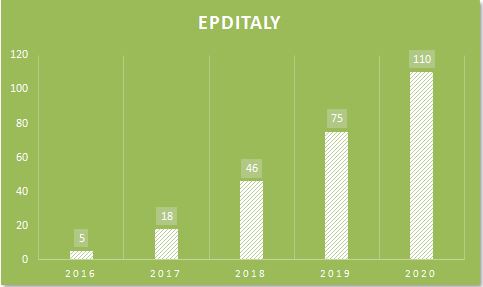EPD have almost tripled in 3 years
Sustainability is one of the priority issues with respect to the Next Generation Eu plan launched by the European Commission and in the near future it will concern all the production sectors of our country.
This trend is already evident from some important data regarding certifications relating to sustainable products, in particular the EPD (Environmental Product Declaration), a term that derives from the English Environmental Product Declaration: a document that describes the environmental impacts related to the production of a specific quantity of product or service, such as energy and raw material consumption, waste production, atmospheric emissions and discharges into water bodies.
The data provided by Eco Platform (an association that brings together the main European Program Operators, including EPDItaly) show how the numbers of certifications have doubled in just two years. In fact, the data reveal that the beginning of 2021 marked the exceeding of 10,000 world EPDs published in the construction sector and compliant with EN 15804. To understand the extent of this number and the growth rate of the last two years, it is necessary to know that in 2018 these EPDs were less than 5,000, so the growth was 100% in two years.
As for Italy, EPDItaly, the Italian program operator, has recorded growth of 139% in just three years, going from 46 EPDs published in 2018 to 110 in 2020. The difference between 2019 and 2020 is definitely notable: in just one year, publications grew by 47%.

This is an important signal for companies to start up increasingly sustainable processes and above all the desire to attest to this attention to the recovery of materials, respect for the environment and the resources available to us. The most present sector is still that of construction, with almost the total of EPDs published on the EPDItaly portal, but certifications relating to the service sector, electricity and manufacturing are also increasing.
The advantages of EPD for companies
There are specific reasons why companies choose voluntary certification for their products:
1. To use the EPD as an effective marketing tool, able to enhance their products, favoring their positioning on international markets.
2. To optimize production processes and reduce costs within the company, monitoring the improvement over time of the environmental performance of products or services.
3. To enhance the corporate brand by adopting a transparency policy towards stakeholders.
4. To counter the phenomenon of Greenwashing through the help of independent third party bodies that validate the information communicated.
5. To trace the environmental performance along the entire production chain in a clear, transparent and objective way.
6. To comply with legal obligations (eg. CAM – Minimum Environmental Criteria)
The benefits of EPD for consumers
The advantages also concern the end customer who carefully selects materials and products for their home, family or personal well-being. Consumers today have the opportunity to make informed choices, with a view to environmental sustainability. Thanks to the EPD, a consumer can:
1. Knowing the environmental performance validated by an accredited third-party organization of the products it is purchasing.
2. Contribute to safeguarding the ecosystem by choosing products and services that have less impact than others on the market.
3. The choice of materials whose environmental impacts are certified, in the case of properties or buildings, can increase the quality standard and therefore the economic value.

